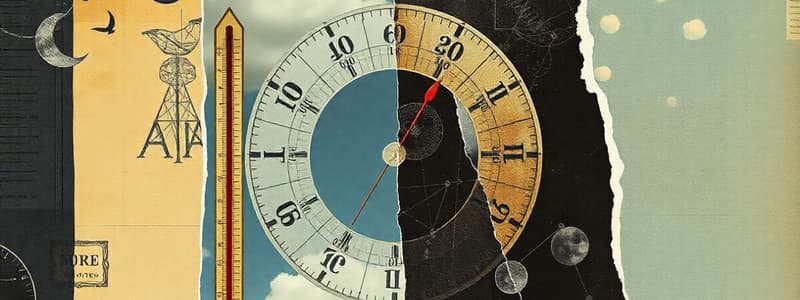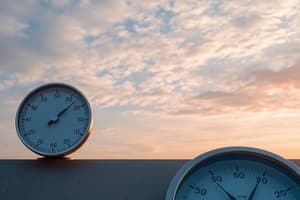Podcast
Questions and Answers
A region experiences consistently clear skies and minimal wind. Barometer readings are steadily increasing over several hours. Which type of pressure system is most likely influencing this area?
A region experiences consistently clear skies and minimal wind. Barometer readings are steadily increasing over several hours. Which type of pressure system is most likely influencing this area?
- A stationary front system.
- A dissipating low-pressure system.
- A developing low-pressure system.
- A high-pressure system. (correct)
In the Northern Hemisphere, air moves from areas of high pressure to low pressure. Considering the Coriolis effect, which direction would surface winds generally rotate around a low-pressure system?
In the Northern Hemisphere, air moves from areas of high pressure to low pressure. Considering the Coriolis effect, which direction would surface winds generally rotate around a low-pressure system?
- Counterclockwise and outward.
- Clockwise and outward.
- Counterclockwise and inward. (correct)
- Clockwise and inward.
If a coastal city is experiencing prolonged heavy rainfall and flooding, and meteorologists report barometric pressures significantly below 1013mb and decreasing, what type of weather system is most likely responsible?
If a coastal city is experiencing prolonged heavy rainfall and flooding, and meteorologists report barometric pressures significantly below 1013mb and decreasing, what type of weather system is most likely responsible?
- A typical high-pressure system.
- A strengthening low-pressure system. (correct)
- A weakening low-pressure system.
- A transitioning high-pressure system.
A farmer is concerned about a developing drought in their region. Weather forecasts indicate a persistent high-pressure system over the area for the foreseeable future. Why would a high-pressure system contribute to drought conditions?
A farmer is concerned about a developing drought in their region. Weather forecasts indicate a persistent high-pressure system over the area for the foreseeable future. Why would a high-pressure system contribute to drought conditions?
Consider two locations: Location X within a high-pressure system and Location Y within a low-pressure system. If both locations are at sea level, how will their barometric pressure readings typically compare to the standard atmospheric pressure at sea level (approximately 1013mb)?
Consider two locations: Location X within a high-pressure system and Location Y within a low-pressure system. If both locations are at sea level, how will their barometric pressure readings typically compare to the standard atmospheric pressure at sea level (approximately 1013mb)?
During summer, a region experiences several days of unusually high temperatures under a high-pressure system. Which of the following hazards is most directly associated with this prolonged high-temperature event?
During summer, a region experiences several days of unusually high temperatures under a high-pressure system. Which of the following hazards is most directly associated with this prolonged high-temperature event?
In comparing the air pressure at the center of a pressure system to its surrounding areas, which statement accurately describes the pressure difference between high and low-pressure systems?
In comparing the air pressure at the center of a pressure system to its surrounding areas, which statement accurately describes the pressure difference between high and low-pressure systems?
Which of the following best describes the relationship between elevation and air pressure?
Which of the following best describes the relationship between elevation and air pressure?
A meteorologist observes a location with air pressure higher than its surrounding areas. According to the principles of meteorology, what kind of weather system is most likely present?
A meteorologist observes a location with air pressure higher than its surrounding areas. According to the principles of meteorology, what kind of weather system is most likely present?
Which of the following statements accurately describes how the Coriolis Effect influences high-pressure systems?
Which of the following statements accurately describes how the Coriolis Effect influences high-pressure systems?
A digital barometer records air pressure readings over several days. How does this type of barometer store and present this data?
A digital barometer records air pressure readings over several days. How does this type of barometer store and present this data?
Which of the following best explains why cool air is associated with high-pressure systems?
Which of the following best explains why cool air is associated with high-pressure systems?
If a mercury barometer shows a rapid decrease in the height of the mercury column, what does this typically indicate about the atmospheric conditions?
If a mercury barometer shows a rapid decrease in the height of the mercury column, what does this typically indicate about the atmospheric conditions?
Consider that you are hiking on a mountain, and you check your digital barometer, which reads 950 hPa (hectopascals). If you descend to a valley and check the barometer again, what reading would you expect to see?
Consider that you are hiking on a mountain, and you check your digital barometer, which reads 950 hPa (hectopascals). If you descend to a valley and check the barometer again, what reading would you expect to see?
Why are barometers important tools for both navigation and weather prediction?
Why are barometers important tools for both navigation and weather prediction?
Flashcards
Air Pressure
Air Pressure
The weight of air at a specific location.
Barometer
Barometer
Instrument used to measure air pressure.
Mercury Barometer
Mercury Barometer
Measures air pressure using mercury levels in a tube.
Aneroid Barometer
Aneroid Barometer
Signup and view all the flashcards
Digital Barometer
Digital Barometer
Signup and view all the flashcards
High-Pressure System
High-Pressure System
Signup and view all the flashcards
High-Pressure Rotation
High-Pressure Rotation
Signup and view all the flashcards
Formation of High-Pressure Systems
Formation of High-Pressure Systems
Signup and view all the flashcards
High-Pressure System Measurements
High-Pressure System Measurements
Signup and view all the flashcards
High-Pressure System Weather
High-Pressure System Weather
Signup and view all the flashcards
High-Pressure System Hazards
High-Pressure System Hazards
Signup and view all the flashcards
Low-Pressure Systems
Low-Pressure Systems
Signup and view all the flashcards
Low-Pressure System Measurements
Low-Pressure System Measurements
Signup and view all the flashcards
Low-Pressure System Weather
Low-Pressure System Weather
Signup and view all the flashcards
Low-Pressure System Hazards
Low-Pressure System Hazards
Signup and view all the flashcards
Study Notes
- Meteorology studies weather, significantly influenced by air pressure.
- Air pressure is the measure of air's weight at a location.
- Higher air particle density above means increased pressure, and vice versa.
- Air pressure is higher at the beach (low elevation) compared to mountains (high elevation).
- Earth's rotation causes High- and low-pressure systems to emerge worldwide.
Measuring Air Pressure
- Barometers measure air pressure, with mercury, aneroid, and digital types available.
- Mercury barometers use mercury levels in a tube to measure pressure changes.
- Pressure is measured in millimeters of mercury (mmHg) and converted to atmospheres (atm), Pascals (Pa), or bars.
- Aneroid barometers use metal parts instead of mercury; a needle indicates pressure in atmospheres or bars.
- Digital barometers use rubber pieces, storing data on computer chips, and are found in smartphones.
- Combining barometers with other tools improves navigation and weather forecasts.
High-Pressure Systems
- High-pressure systems or anticyclones have higher pressure than their surroundings.
- They rotate clockwise in the Northern Hemisphere and counterclockwise in the Southern Hemisphere due to the Coriolis Effect.
- Formation occurs as air cools, becomes denser, and sinks, increasing surface pressure.
- High-pressure systems typically measure above 1013 millibars (mb) up to 1050 mb.
- Pressure readings increase towards the system's center, indicating highest pressure there.
- High-pressure systems usually bring clear, dry weather with minimal wind due to small pressure differences.
High-Pressure System Hazards
- Heat waves occur when a high-pressure system causes temperatures above average for two to five days.
- Heat waves result in heat exhaustion, heat strokes, and deplete energy due to increased air conditioning use.
- Extended high-pressure systems can cause droughts due to evaporation and lack of rain.
- Droughts affect water resources, harm ecosystems, and impact irrigation.
Low-Pressure Systems
- Low-pressure systems or cyclones have lower pressure than their surroundings.
- Low-pressure systems revolve counterclockwise in the Northern Hemisphere and clockwise in the Southern Hemisphere, due to the Coriolis Effect.
- They form as air warms, becomes less dense, and rises, decreasing surface pressure.
- Low-pressure systems measure below 1013mb down to 980mb.
- Pressures below 980mb indicate higher chances of extreme weather.
- Pressure readings decrease towards the system's center, showing the lowest pressure there.
- Low-pressure systems bring cooler temperatures, condensation, and cloud formation.
- Low pressure Systems are Needed to water crops and balance air temperatures.
Low-Pressure System Hazards
- Extended low-pressure systems can cause major flooding, impacting homes, businesses, and ecosystems.
- Short, powerful downpours from low-pressure systems can cause flash floods, affecting road travel.
- Extremely low pressure at the center of a cyclone can lead to tornadoes due to fast-moving winds.
- Tornadoes are fast-forming, fast-moving, and violent, causing destruction.
- Hurricanes develop when low-pressure systems receive extra water from the ocean.
- Warm temperatures and water intensify winds, causing high winds, flooding, and ecosystem changes.
Studying That Suits You
Use AI to generate personalized quizzes and flashcards to suit your learning preferences.




